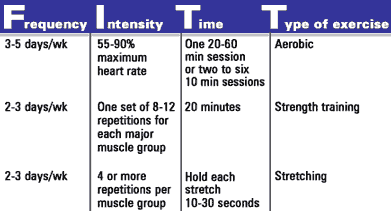
How much exercise do you really need?
I used to think of exercise as an all-or-none phenomenon. On
any given day I either did something strenuous, like running or
hiking, or I rested. But now that I'm older (and hopefully wiser),
my body doesn't like either extreme. I feel and function better
with daily amounts of moderate activity.
Recently, scientific research has confirmed the value of this
type of routine. Fitness experts now advocate that for optimum
health, adults should get at least 30 minutes of moderate-intensity
exercise on most, if not all, days of the week. (A moderate level
of exercise is defined as that which burns 150 calories a day,
or 1,050 calories each week.) Physical activities can be performed
at one time or spread throughout the day.
The health benefits that come from this kind of commitment to
exercise are astounding. Studies show that staying fit can help
lower your blood pressure and cholesterol; reduce your risk of
heart disease, cancer, and diabetes; preserve your bones and joints;
prevent muscle loss and weight gain; improve your mood, memory,
and sleep; and prolong your life. The list goes on, but let's
get down to the nitty-gritty: Exactly how much exercise do you
need to achieve good health?
Recommendations for getting FITT
The American College of Sports Medicine makes the following recommendations
for the types and amounts of exercise you need for overall health
and fitness:

Exercising your options
If sweating on a stationary bike just isn't your style, take
heart. Whether you prefer shooting hoops or gardening, there are
plenty of activities you can incorporate into your daily routine.
The National Heart, Lung, and Blood Institute offers tips on ways
to include more moderate-intensity exercise in your lifestyle.
As the table below shows, more strenuous activities should be
done for a shorter amount of time, while less strenuous activities
should be done for longer. To avoid injury, start slowly and gradually
increase your intensity.
Precautions before you begin
Physical activities can stress your body and heart, so get clearance
from your health care provider before starting an exercise program.
This is especially important if you are physically inactive; overweight;
over age 40; acutely or chronically ill from heart, lung, or other
diseases; or if you have risk factors for heart disease, such
as smoking, high cholesterol, high blood pressure, diabetes, or
a family history of heart disease.
Elizabeth Smoots, M.D., F.A.A.F.P., is a board-certified
family physician in Seattle, Washington. A fellow of the American
Academy of Family Physicians, Dr. Smoots specializes in prevention
and primary care medicine.

